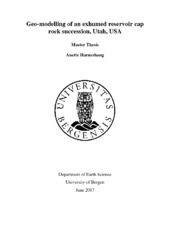Geo-modelling of an exhumed reservoir cap rock succession, Utah, USA
Master thesis
Permanent lenke
https://hdl.handle.net/1956/16108Utgivelsesdato
2017-06-23Metadata
Vis full innførselSamlinger
- Department of Earth Science [1050]
Sammendrag
Carbon capture and storage (CCS) can potentially play an important role in mitigating global CO2 emissions. The storage sites must be understood in detail to ensure safe storage on a millennial time scale. Outcrop analogs have been studied in order to enhance the understanding of the subsurface in regards of reservoir properties, sand body connectivity and vertical developments. An exhumed paleo-reservoir in Utah, Humbug Flats, is of special interest as it shows evidence for CO2 accumulation and leakage through bleaching of the outcrop. This paleo-reservoir can therefore be used as an analog to potential locations for CO2 storage. The main objective of this thesis is to compile and systemize data from previous studies in the area of the outcrop collected by the COPASS project. Issues related to acquisition and merging of multi-source collected outcrop data are identified and described. Facies associations have been mapped in 3D by the use of Lidar images and sedimentary logs. A modelling workflow is developed for RMSTM (reservoir modelling program), implementing available data into one coherent geo-model. Problems related to merging of multi-source datasets, input data quality and model implementation are identified and addressed. The model set-up provided is considered robust for further work in the project.
Beskrivelse
Revised version: some spelling errors corrected
